![]()
![]()
![]()
Use LEFT and RIGHT arrow keys to navigate between flashcards;
Use UP and DOWN arrow keys to flip the card;
H to show hint;
A reads text to speech;
17 Cards in this Set
- Front
- Back
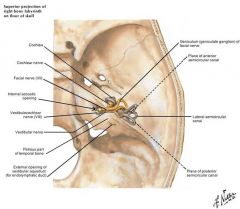
|
Point: complex structural area
|
|
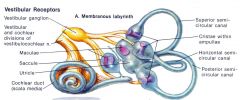
|

membranous labryinth with sensory organs (purple) in the vestibular apparatus.
Muculae in saccule and utricle and cristae within ampullae; these are areas of sensory perception of position and motion. Its filled with endolymph and floats within perilymph |
|
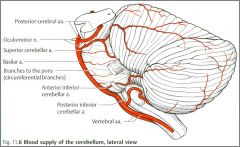
|

can see mixed central and peripheral vestibulopathies; due to circulatory issues of anterior inferior cerebellar artery which supplies the lampryinth; if affected proximal can also cause a cerebellar infarct
|
|
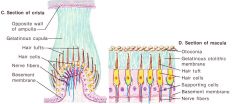
crista and maculae
|

|
|
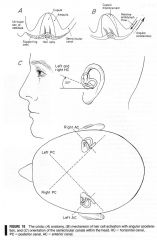
linear force; sacculae
angular forces; maculae |

crista constantly firing tonic inputs to the brain; gives brain a sense of how it is moving in space; as the person turns the fluid shifts in the semicircular canals which activates or deactivates cristae; combo of inputs from 3 canals gives the brain the ability to determine how head is turning relative to space
|
|
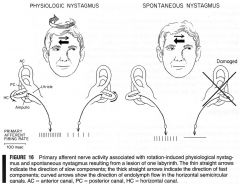
|

As person turns theres a nystagmus opposing the turn; so person rotates to their right, eyes look to the right; right vestibular canals are firing more rapidly, left is suppressed
|
|
|
spontaneous nystagmus
|
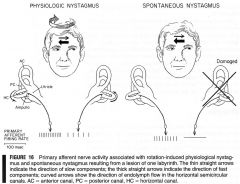
right side tonic input is intact; drives eyes to the left and leads to the compensatory fast component for fixation even though the person isn't moving
|
|
|
cold water test
|
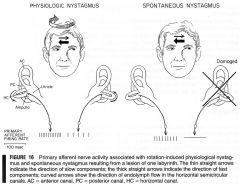
the cold water acts as a destructive lesion to the vestibular apparatus so the eyes look to the lesion (in the person presenting in coma) to demonstrate that the brainstem is intact
|
|
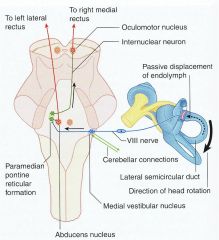
|

similar to lateral conjugate gaze reflex = lateral eye movements via vvestibular inputs
|
|
|
positional testing
|
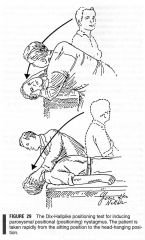
dix-hallpike maneuvers; provocative test to rev up physical manifestations of a damaged organ;
bening paroxysmal positional vertigo; sit person up then rapidly bring them down turning their head; you're looking for 'do they become acutely symptomatic' which is suggestive of peripheral neuropathy and do they have nystagmus |
|
|
main central vertigo symptoms
|
unmatched dysconjugate eye nystagmus; trouble in the cns
|
|
|
Positional symptoms (cant roll over in bed)
|
peripheral neuropathy
|
|
|
Pt complains of dizziness/vertigo getting worse when with visual fixation
|
Reduces nystagmus in peripheral processes; no effect or worsens in central forms of nystagmus
|
|
|
sustained/continous vs extinguishing
|
pns problems have cns to adapt = extinguishing
cns problems do not extinguish they are sustained since there is no adapting mechanism |
|
|
canalithiasis
|
ineralized particles derived from the otoconia (those little rocks that are layered over the maculae of the utricle and saccule) are released and drift into the semicircular canals – usually the posterior semicircular canal –
|
|
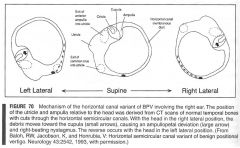
|
canalithiasis variant of benign paroxysmal positional vertigo involving the horizontal (lateral) semicircular canal
|
|
|
drugs can interfere w vestibular organs, depresses cns, cerebellar toxicity, hypotensive drugs reduce perfusion, combos
|
toxic/metabolic causes of dizziness other than vertigo
Drugs: Aminoglycosides, cisplatin Antiepileptics Tranquilizers Antihypertensives, diuretics Alcohol |

